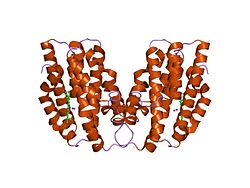1n3u: Crystal structure of human heme oxygenase 1 (HO-1) in complex with its substrate heme, crystal form B
1n45: X-RAY CRYSTAL STRUCTURE OF HUMAN HEME OXYGENASE-1 (HO-1) IN COMPLEX WITH ITS SUBSTRATE HEME
1ni6: Comparisons of the Heme-Free and-Bound Crystal Structures of Human Heme Oxygenase-1
1oyk: Crystal Structures of the Ferric, Ferrous, and Ferrous-NO Forms of the Asp140Ala Mutant of Human Heme Oxygenase-1: Catalytic Implications
1oyl: Crystal Structures of the Ferric, Ferrous, and Ferrous-NO Forms of the Asp140Ala Mutant of Human Heme Oxygenase-1: Catalytic Implications
1oze: Crystal Structures of the Ferric, Ferrous, and Ferrous-NO Forms of the Asp140Ala Mutant of Human Heme Oxygenase-1:Catalytic Implications
1ozl: Crystal Structures of the Ferric, Ferrous, and Ferrous-NO Forms of the Asp140Ala Mutant of Human Heme Oxygenase-1: Catalytic Implications
1ozr: Crystal Structures of the Ferric, Ferrous and Ferrous-NO Forms of the Asp140Ala Mutant of Human Heme Oxygenase-1: Catalytic Implications
1ozw: Crystal Structures of the Ferric, Ferrous and Ferrous-NO Forms of the Asp140Ala Mutant of Human Heme Oxygenase-1: Catalytic Implications
1s13: Human Heme Oxygenase Oxidatition of alpha- and gamma-meso-Phenylhemes
1s8c: Crystal structure of human heme oxygenase in a complex with biliverdine
1t5p: Human Heme Oxygenase Oxidation of alpha- and gamma-meso-phenylhemes
1twn: Crystal structures of ferrous and ferrous-NO forms of verdoheme in a complex with human heme oxygenase-1: catalytic implications for heme cleavage
1twr: Crystal structures of ferrous and ferrous-NO forms of verdoheme in a complex with human heme oxygenase-1: catalytic implications for heme cleavage
1xjz: Crystal Structures of the G139A, G139A-NO and G143H Mutants of Human Heme Oxygenase-1
1xk0: Crystal Structures of the G139A, G139A-NO and G143H Mutants of Human Heme Oxygenase-1
1xk1: Crystal Structures of the G139A, G139A-NO and G143H Mutants of Human Heme Oxygenase-1
1xk2: NADPH- and Ascorbate-Supported Heme Oxygenase Reactions are Distinct. Regiospecificity of Heme Cleavage by the R183E Mutant
1xk3: NADPH- and Ascorbate-Supported Heme Oxygenase Reactions are Distinct. Regiospecificity of Heme Cleavage by the R183E Mutant
























